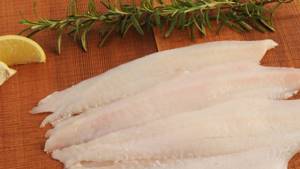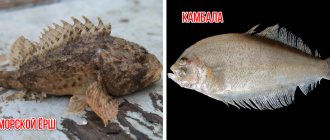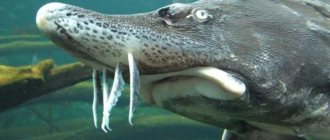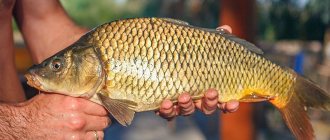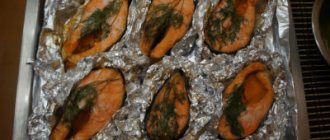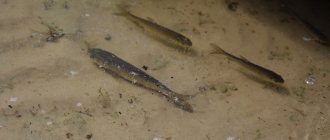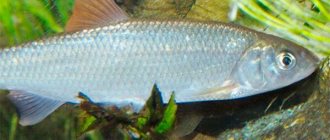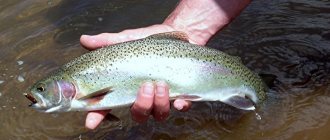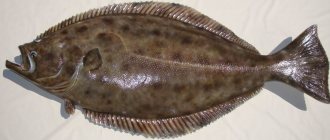Do flounder have scales?
There are two types of flounder that can be purchased in the store, with and without scales. Both types are pleasant to the taste and can be used as food. You can consume it by removing the husk and skin. Many people think that flounder without scales does not require cleaning, but this is not true. The skin is dense and rough. In addition, it adds bitterness to the finished dish. Accordingly, the fish must be cleaned of skin and scales.
Do flounder have scales?
Cutting and gutting
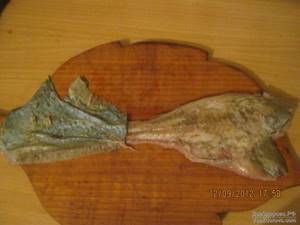
The head of a flounder is removed last, since the organs of this fish are not located in the lower part of the body, but immediately under the gills. If you cut the product carelessly, you can damage the gallbladder, which will negatively affect the taste of the future dish.
In order to separate the head, a V-shaped cut is made on both sides of the fish, after which the head and entrails are carefully removed. This must be done in one quick movement.
How to defrost flounder quickly?
There is one and the surest way to defrost flounder - this is to put it in plastic on the bottom shelf in the refrigerator and leave it until completely thawed. But if you don't have time, try another method.
Instructions for quick defrosting:
- Immerse the fish in a container of cold water
- First add salt to the container.
- It should be 10 g per 1 kg of product
- Turn the fish over from time to time to check the rate of thawing
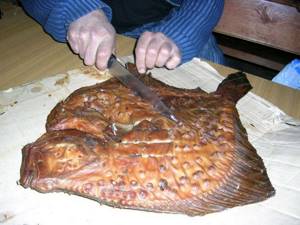
How to defrost flounder quickly?
Useful properties of flounder
Flounder is one of the components of almost all health-improving diets, and this fact undoubtedly proves that the fish has a huge supply of beneficial properties. Flounder meat contains a lot of useful and fully digestible protein, which is required daily by our body.
It also contains a lot of Omega-3 fatty acids and phosphorus salts. Also contains: riboflavin, thiamine, pyridoxine, nicotinic and pantothenic acids. Flounder meat is very rich in B vitamins (especially B12); vitamins D, E and A, which are also present in this fish, also have a positive effect on health.
The beneficial effect of flounder on the body is also proven by the content of amino acids in it: threonine, glycine, aspartic and glutamic acids. Amino acids are very necessary for humans and they are ways to lower cholesterol levels in the blood.
The potassium, sodium, iron, calcium, magnesium, zinc, phosphorus and other minerals, micro- and macroelements contained in flounder are extremely beneficial for humans, which:
- regulate water-salt metabolism;
- help convert glucose into energy;
- are a good building material for teeth and bones;
- participate in the formation of hemoglobin in the blood;
- ensure the functioning of enzymes;
- improve muscle and mental activity.
Bondage meat is also rich in iodine, which in turn improves performance and immunity.
Flounder has another interesting property - it increases sexual desire, all thanks to the presence of aphrodisiacs in its composition. This property is inherent only in some species of fish.
Eating flounder meat promotes excellent strengthening of nails and hair, thanks to vitamins, minerals and polyunsaturated acids. It also speeds up the wound healing process.
Entering the body as food, flounder meat increases skin elasticity and promotes good rejuvenation of the body.
For people who control their weight and lead an active lifestyle, flounder is very healthy, especially if you cook it outdoors on a grill. After all, the balanced composition of fish will help keep your figure in shape.
Record holders for the presence of iodine, cobalt, phosphorus
Dangerous properties of flounder
First of all, flounder should not be eaten by people who are allergic to the protein in the meat of this fish.
It can also harm people who have liver and kidney problems in large quantities. Remember that fish may pick up some harmful elements from the water that can be harmful to health, such as mercury or heavy metals. Therefore, you must be sure of the high quality of the fish you buy. This should be a place where environmental tests are carried out to show the health of the fish. It is especially worth keeping an eye on this if you are giving meat to a child.
Find out from the video how flounder is caught in the Baltic Sea in autumn.
Tatyana Eliseeva chief editor of the Food+ project
Ask a Question
Rating:
8.2
/10
Votes: 9
Usefulness of material 8.3
Reliability of information 7
Formatting of Article 9.3
Do I need to gut and clean frozen flounder and remove the black skin before frying?
Although some types of flounder are sold without scales, the skin must also be removed. It is very dense, so it can significantly spoil the taste of the finished dish. It is also worth removing the black film and fins.
Many people don't want to bother and don't remove the skin. This can significantly degrade the taste of the dish. This skin imparts bitterness and an unpleasant iodine taste.
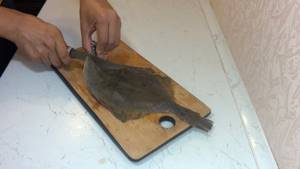
Do I need to gut and clean frozen flounder and remove the black skin before frying?
How to properly clean the Black Sea spiny flounder?
In general, this type of fish is quite difficult to clean. Many housewives complain that part of the meat is removed along with the thorns. After the procedure, all my hands were scratched. That is why it is recommended to gut such fish and not touch the spines. After heat treatment, they easily fall off.
If desired, the thorns can be cut off with very sharp scissors. It is better not to cut with a knife, as you risk piercing your hands and removing most of the tender meat.
Now in Italy there is a real boom in some dishes of the Black Sea cuisine. One of the most popular dishes is kalkan flounder with spikes. Cooks do not cut off the thorns, since they are a delicacy. The fish is simply fried in a large amount of oil, seasoned with thyme and rosemary. After frying, the spikes become crispy and very tasty, and underneath is tender meat.
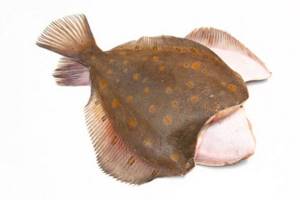
How to properly clean the Black Sea spiny flounder?
Features of cleaning before heat treatment
Pay attention to the features of preparing flounder for various types of heat treatment.
Cooking
In order to cook flounder, it is cut according to the usual pattern. In this case, it is not necessary to use fillet, because the bones of boiled fish can be easily separated.
The most important thing is to remember to remove the skin from the carcass so as not to spoil the taste of the dish.
I also recommend salting the meat before you start cooking and letting the salt soak in.
Baking and frying
If you decide to cook flounder in the oven or in a frying pan, do not forget to cut off the fins, remove the spines, if any, and gut the carcass. In this case, the skin does not need to be removed.
Salt the flounder and add the necessary spices before starting heat treatment.
How to properly clean flounder: tips and tricks
In general, there are a lot of cleaning options, but in any case you will have to spend a decent amount of time to clean and gut the marine life. Therefore, if you are not confident in your abilities, purchase ready-made fillets. But remember, chilled fish contains a lot of useful substances that disappear after freezing and thawing.
Sample cleaning instructions:
- Use a sharp knife to scrape off the scales
- Make cuts near the head and carefully remove the skin
- Remove the fish's head
- Starting from the head and moving towards the tail, rip open the abdomen
- Carefully remove the giblets and, if necessary, the central bone, starting the filleting process from the light side of the carcass

How to properly clean flounder: tips and tricks
Black Sea Kalkan recipe
So, first of all, you need to cut out the head and carefully trim the fins and tail in a circle (you can use kitchen scissors).
Next, you need to remove the insides, which simply stand out from the peritoneum.
After this, we cut the carcass in half along the body along the ridge; here you will need a little effort.
Next, cut each half into portioned vertical pieces no more than 3 cm wide.
Before frying, salt and pepper and lightly spray the pieces with extra virgin olive oil.
The roasting technology is traditional: the pieces are rolled in corn or wheat flour and laid out in slices
in a preheated frying pan with refined olive oil and rosemary.
Flounder is fried only on both cut sides
until golden brown over medium heat.
After frying, place the fish well on a paper towel. For a side dish, we prepared potatoes baked with olive oil, paprika and cumin.
Don't miss the opportunity to cook and try this wonderful fish, believe me, it will meet all your expectations!
How to separate flounder meat from bones, cut frozen flounder into fillets: instructions, tips
Many housewives recommend initially gutting the sea creature, and only then proceeding to remove the skin and scales. It really works. After all, it is easier to remove the skin from frozen fish, but from fresh fish it is removed along with the meat.
Instructions:
- Using a sharp knife or scissors, remove the tail, fins and head. It must be cut off along with the pieces of meat.
- After this, use a sharp knife to rip open the belly and remove the entrails. Scrape off the black film with a knife and rinse the fish.
- Now turn it inside out and remove the bone that is located in the middle.
- Along with this bone, some small bones will be removed. As a result, you will get a layer with skin and scales.
- If there are scales, scrape them off. If the fish is without scales, remove the skin. To do this, the skin is pryed off with a sharp knife and removed like a stocking. As a result, you will get a finished fillet.

Cleaning flounder is not an easy task.
But following our tips, you will quickly cope and please your loved ones with a delicious dinner.
Preparing fillets for frying
For frying, it is preferable to take flounder fillet, so the fish will cook quickly and efficiently. To get even fillet pieces, choose a medium or large size in the store.
Making fillet is easy:
- cut the fish, removing fins, scales and skin;
- remove the head and remove the entrails;
- on the dark side of the fish, make a longitudinal cut in the direction from the tail to the head;
- cut the fish on the sides, using a knife blade to reach the bones;
- insert the knife into the cut made and, using short movements, separate the flesh, sliding over the bones (lift the separated pieces of meat with your hand);
- turn the flounder over to the light side and repeat the manipulations.
